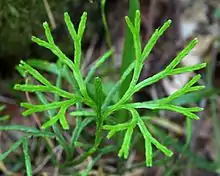
Liquid-preserved strobili of Lycopodium sp., showing reniform sporangia through translucent sporophylls.
Taxonavigation
| Taxonavigation: Lycopodiales |
|---|
|
Superregnum: Eukaryota |
Familia: Lycopodiaceae
Subfamiliae: Lycopodielloideae –
Lycopodiastroideae –
Lycopodioideae –
Huperzioideae
Genera:
Austrolycopodium –
Brownseya –
Dendrolycopodium –
Diphasiastrum –
Diphasium –
Huperzia –
Lateristachys –
Lycopodiastrum –
Lycopodiella –
Lycopodium –
Palhinhaea –
Phlegmariurus –
Phylloglossum –
Pseudodiphasium –
Pseudolycopodiella –
Pseudolycopodium –
Spinulum
Name
Lycopodiaceae P.Beauv. in Lamarck & Mirbel, Hist. Nat. Veg. 4: 293 (1802).
- Type genus: Lycopodium L., (1753)
Synonyms
- Heterotypic
- Huperziaceae Rothm., Feddes Repert. 66: 236 (1962), nom. nov.
- Urostachyaceae Rothm., Feddes Repert. 54: 58 (1944), nom. illeg.
- Phylloglossaceae Kunze, Bot. Zeit. (Berlin) 1: 722 (1843).
- Lycopodiellaceae Val.N.Tikhom., Novosti Sist. Vyssh. Rast. 49: 149 (2018).
- Huperziaceae Rothm., Feddes Repert. 66: 236 (1962), nom. nov.
References
Additional references
- Øllgaard, B. 1987. A revised classification of the Lycopodiaceae s. lat. Opera Botanica 92: 153–178. Reference page.
- Christenhusz, M.J.M., Zhang, X.-C. & Schneider, H. 2011. A linear sequence of extant families and genera of lycophytes and ferns. Phytotaxa 19: 7–54. DOI: 10.11646/phytotaxa.19.1.2
 . Reference page
. Reference page - Pteridophyte Phylogeny Group (PPG I) 2016. A community-derived classification for extant lycophytes and ferns. Journal of Systematics and Evolution 54(6): 563–603. DOI: 10.1111/jse.12229 Reference page.
- Greuter, W. & Troìa, A. 2014. (2292) Proposal to conserve the name Palhinhaea against Lepidotis (Lycopodiaceae). Taxon 63(3): 680–682. DOI: 10.12705/633.23 Reference page. (authorship of Palisot de Beauvois)
Links
- Govaerts, R. et al. 2022. Lycopodiaceae in Kew Science Plants of the World online. The Board of Trustees of the Royal Botanic Gardens, Kew. Published online. Accessed: 2022 Jun 24. Reference page.
- Hassler, M. 2022. World Ferns. Checklist of Ferns and Lycophytes of the World. . Lycopodiaceae Accessed: 24 Jun 2022.
Vernacular names
العربية: رجل ذئبية
беларуская: Дзеразовыя
català: Licopodiàcies
čeština: Plavuňovité
dansk: Ulvefod-familien
Deutsch: Bärlappgewächse
English: Club-moss family
español: Lycopodiáceas
eesti: Kollalised
فارسی: پنجهگرگیان
suomi: Liekokasvit
français: Lycopodiacées
עברית: רגלי זאב
hrvatski: Crvotočine
magyar: Korpafűfélék
íslenska: Jafnaætt
日本語: ヒカゲノカズラ科
한국어: 석송과
lietuvių: Pataisiniai
latviešu: Staipekņu dzimta
македонски: Црвоточини
Nederlands: Wolfsklauwfamilie
norsk: Kråkefotfamilien
polski: Widłakowate
română: Licopodiacee
русский: Плауновые
slovenščina: Lisičjakovke
svenska: Lummerväxter
українська: Плаунові
oʻzbekcha/ўзбекча: Plaundoshlar
Tiếng Việt: Họ Thạch tùng
中文: 石松科
беларуская: Дзеразовыя
català: Licopodiàcies
čeština: Plavuňovité
dansk: Ulvefod-familien
Deutsch: Bärlappgewächse
English: Club-moss family
español: Lycopodiáceas
eesti: Kollalised
فارسی: پنجهگرگیان
suomi: Liekokasvit
français: Lycopodiacées
עברית: רגלי זאב
hrvatski: Crvotočine
magyar: Korpafűfélék
íslenska: Jafnaætt
日本語: ヒカゲノカズラ科
한국어: 석송과
lietuvių: Pataisiniai
latviešu: Staipekņu dzimta
македонски: Црвоточини
Nederlands: Wolfsklauwfamilie
norsk: Kråkefotfamilien
polski: Widłakowate
română: Licopodiacee
русский: Плауновые
slovenščina: Lisičjakovke
svenska: Lummerväxter
українська: Плаунові
oʻzbekcha/ўзбекча: Plaundoshlar
Tiếng Việt: Họ Thạch tùng
中文: 石松科
| For more multimedia, look at Lycopodiaceae on Wikimedia Commons. |
This article is issued from Wikimedia. The text is licensed under Creative Commons - Attribution - Sharealike. Additional terms may apply for the media files.
